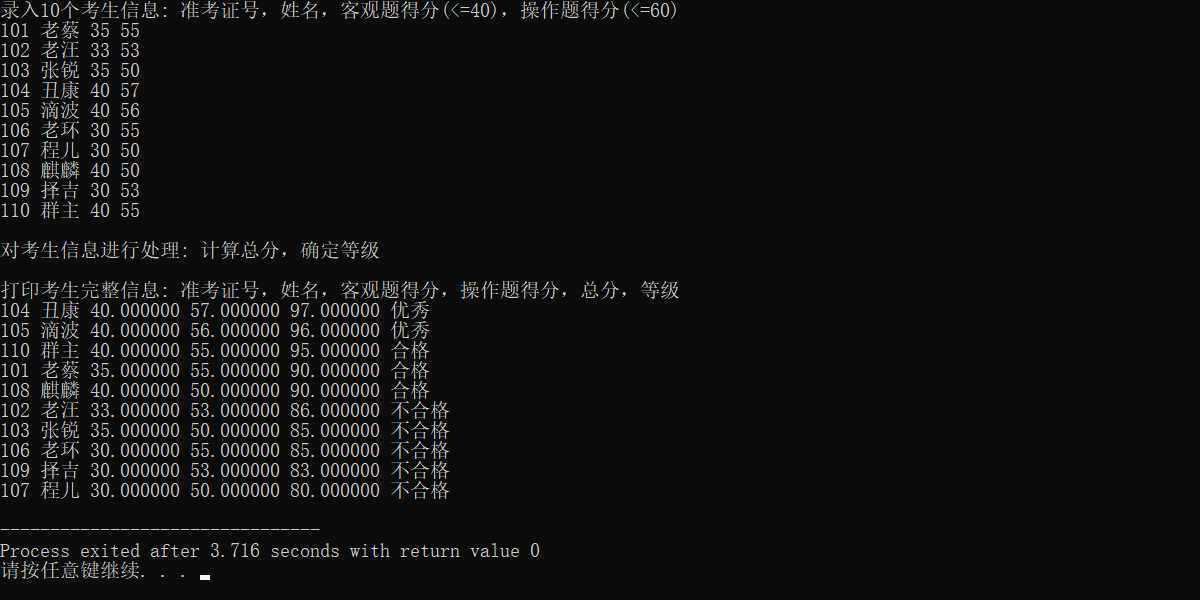标签:赋值语句 dmi 数组 元素 col 活性 存储 难度 用法
实验结论:
Part 1:结构体类型及编程应用
ex1_2.cpp
#include <stdio.h> const int N=5; // 定义结构体类型struct student,并定义STU为其别名 typedef struct student { long no; char name[20]; int score; }STU; // 函数声明 void input(STU s[], int n); int findMinlist(STU s[], STU t[], int n); void output(STU s[], int n); int main() { STU stu[N], minlist[N]; int count; printf("录入%d个学生信息\n", N); input(stu, N); printf("\n统计低分人数和学生信息...\n"); count = findMinlist(stu, minlist, N); printf("\n一共有%d个低分,信息如下:\n", count); output(minlist, count); return 0; } // 输入n个学生信息,存放在结构体数组s中 void input(STU s[], int n) { int i; for(i=0; i<n; i++) scanf("%ld %s %d", &s[i].no, s[i].name, &s[i].score); } // 输出结构体s中n个元素信息 void output(STU s[], int n) { int i; for(i=0; i<n; i++) printf("%ld %s %d\n", s[i].no, s[i].name, s[i].score); } // 在结构体数组s中,查找低分学生的记录,将其存入结构体数组s中 // 形参n是结构体数组s中元素个数 // 函数返回低分的学生人数 int findMinlist(STU s[], STU t[], int n) { int i,k=0,min=100; for(i=0;i<n;i++) if(s[i].score<min) min=s[i].score; for(i=0;i<n;i++) if(s[i].score==min) t[k++]=s[i]; return k; }

ex1_3.cpp
#include <stdio.h> #include <string.h> const int N = 10; // 定义结构体类型struct student,并定义其别名为STU typedef struct student { long int id; char name[20]; float objective; /*客观题得分*/ float subjective; /*操作题得分*/ float sum; char level[10]; }STU; // 函数声明 void input(STU s[], int n); void output(STU s[], int n); void process(STU s[], int n); int main() { STU stu[N]; printf("录入%d个考生信息: 准考证号,姓名,客观题得分(<=40),操作题得分(<=60)\n", N); input(stu, N); printf("\n对考生信息进行处理: 计算总分,确定等级\n"); process(stu, N); printf("\n打印考生完整信息: 准考证号,姓名,客观题得分,操作题得分,总分,等级\n"); output(stu, N); return 0; } // 录入考生信息:准考证号,姓名,客观题得分,操作题得分 void input(STU s[], int n) { int i; for(i=0; i<n; i++) scanf("%ld %s %f %f", &s[i].id, s[i].name, &s[i].objective, &s[i].subjective); } //输出考生完整信息: 准考证号,姓名,客观题得分,操作题得分,总分,等级 void output(STU s[], int n) { int i; for(i=0; i<n; i++) printf("%ld %s %f %f %f %s\n", s[i].id, s[i].name,s[i].objective,s[i].subjective,s[i].sum,s[i].level); } // 对考生信息进行处理:计算总分,排序,确定等级 void process(STU s[],int n) { int i,j; STU temp; for(i=0;i<n;i++) { s[i].sum=s[i].objective+s[i].subjective; if(s[i].sum>95) strcpy(s[i].level,"优秀"); else if(s[i].sum>=90 && s[i].sum<=95) strcpy(s[i].level,"合格"); else strcpy(s[i].level,"不合格"); } for(i=0;i<n-1;i++) for(j=0;j<n-1-i;j++) if(s[j].sum<s[j+1].sum) { temp = s[j]; s[j] = s[j+1]; s[j+1] = temp; } }

Part2: 共用体类型及编程示例
两者表示方式不同,结构体中各成员顺序排列储存,有独立存储位置;
共用体所有成员共享同一片存储区,更具灵活性,节省内存。
共用体用法与结构体完全相同,总的来说共用体方便设计人员在同一内存区对不同数据类型的交替使用。
Part3: 枚举类型及编程示例
枚举为整型常量,变量取值不能超过定义范围,
一般形式:enum枚举名{枚举值表};
不能直接用赋值语句再赋值,所以不能把一个int型数值赋值给一个枚举类型的变量,反过来可以。
实验总结与体会:
踩坑的话符号容易缺失。。还有将关系运算符整成赋值运算符的蠢错误。。
个人要想再没资料的情况写出这么长的代码还是有很大难度,需要推导和验证许多次,
但总体过程收获也会更多吧,还是多尝试才能更好汲取知识运用到实际中。
标签:赋值语句 dmi 数组 元素 col 活性 存储 难度 用法
原文地址:https://www.cnblogs.com/1346si/p/10974912.html